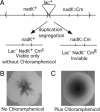Evidence that feedback inhibition of NAD kinase controls responses to oxidative stress
- PMID: 16682646
- PMCID: PMC1472491
- DOI: 10.1073/pnas.0602494103
Evidence that feedback inhibition of NAD kinase controls responses to oxidative stress
Abstract
Formation of NADP+ from NAD+ is catalyzed by NAD kinase (NadK; EC 2.7.1.23). Evidence is presented that NadK is the only NAD kinase of Salmonella enterica and is essential for growth. NadK is inhibited allosterically by NADPH and NADH. Without effectors, NadK exists as an equilibrium mixture of dimers and tetramers (KD = 1.0 +/- 0.8 mM) but is converted entirely to tetramers in the presence of the inhibitor NADPH. Comparison of NadK kinetic parameters with pool sizes of NADH and NADPH suggests that NadK is substantially inhibited during normal growth and, thus, can increase its activity greatly in response to temporary drops in the pools of inhibitory NADH and NADPH. The primary inhibitor is NADPH during aerobic growth and NADH during anaerobic growth. A model is proposed in which variation of NadK activity is central to the adjustment of pyridine nucleotide pools in response to changes in aeration, oxidative stress, and UV irradiation. It is suggested that each of these environmental factors causes a decrease in the level of reduced pyridine nucleotides, activates NadK, and increases production of NADP(H) at the expense of NAD(H). Activation of NadK may constitute a defensive response that resists loss of protective NADPH.
Conflict of interest statement
Conflict of interest statement: No conflicts declared.
Figures



References
Publication types
MeSH terms
Substances
Grants and funding
LinkOut - more resources
Full Text Sources
Other Literature Sources
Molecular Biology Databases

